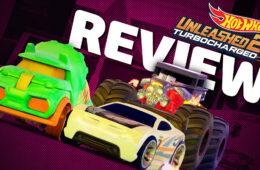I love speed. When not flying down hills on my mountain bike, I can be found redlining my sports car in fifth and sixth gears, sometimes reaching speeds of up to 70 miles per hour – naturally only on motorways or dual carriageways…
So, imagine my excitement when, in December last year, we reported that indie developer Repixel8 would be releasing a super-speedy F-Zero/ wipE’out” inspired racer to PC and Xbox in 2022.
Gravity Chase has been created from the ground up by Repixel8’s Andrew Jeffreys. That means graphics, music, programming, quite literally everything. It’s an indie game in every sense of the word – there are no big budgets here, no art department and certainly not a full team of developers to fall back on during ‘crunch time.’
Following on from Repixel8’s previous stab at the racing genre in the impressive Formula Retro Racing, the question is can Gravity Chase hit these heights again?
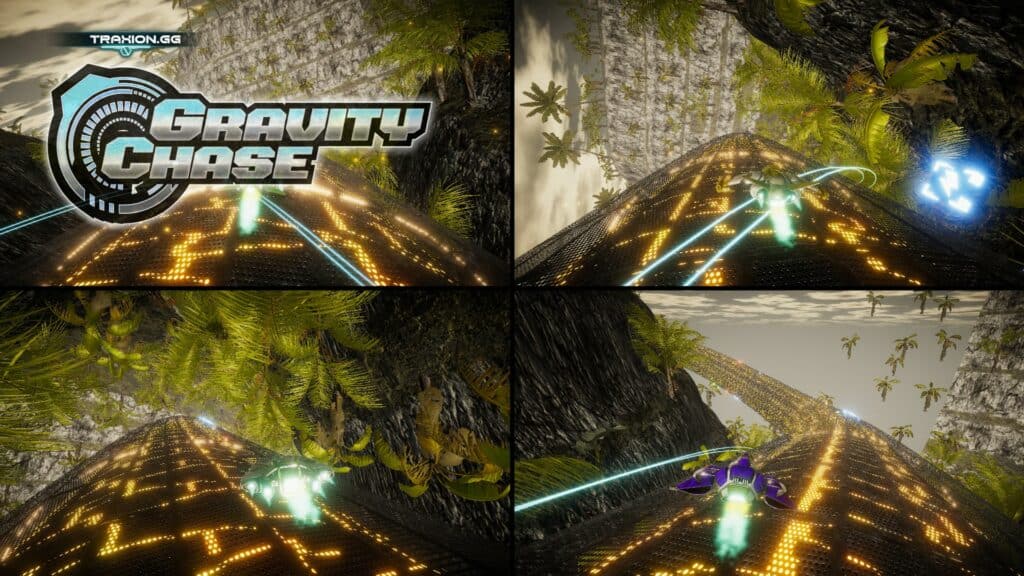
Blindingly fast
Booting up the game, Gravity Chase’s demo mode begins with game engine footage of a two-player split-screen race in action. The graphics are crisp, the gameplay slick and the music is clearly inspired by The Weeknd’s ‘Blinding Lights’, which gives you an immediate idea of the sort of quality being aimed for.*
The main menu has only two options; Race or Quit. Choose Race and you’re presented with a screen that allows another three players to join the game locally, with a 10s countdown to do so – clearly inspired by classic arcade games of the past. You can’t skip this countdown, unfortunately, which seems strange given it’s pitched as a super-speedy racer.
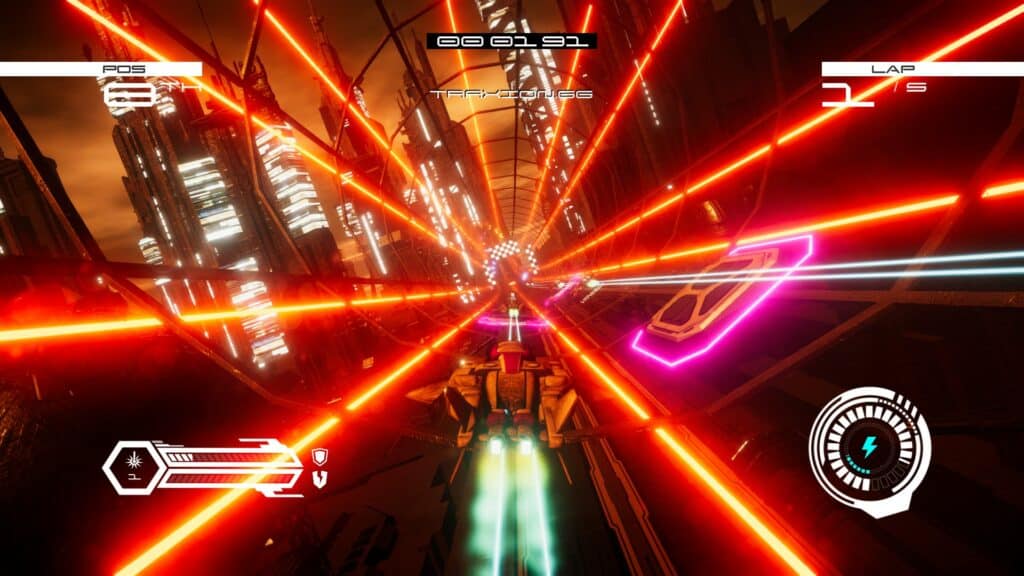
Next, you pick a track to race on, choosing from Arcade, Combat or Eliminator races. By placing highly in these – and getting bonuses for upping the difficulty – you can unlock all 16 tracks and earn enough money to put towards upgrading one or all of the available ten ships.
The ships are separated into three-speed classes, with varying stats for Max Speed, Acceleration, Weight, Handling and Strength. You can use the stats strategically – so a ship with high max speed and acceleration is perfect for straightforward Arcade races, while ships with higher Strength stats will suit Combat and Eliminator races. More on those later. Suffice to say, I found the difficulty ramps up significantly as you move up the speed classes.
After you’ve picked a ship colour – there are eleven options – you’re placed into a futuristic anti-gravity world of neon lights, bass-tastic music and speed. A lot of speed.
Speed 3 – Gravity Chase
Did I mention speed? Yes? Ah, ok. As a huge fan of the F-Zero franchise – especially after losing a whole summer of my life to F-Zero X on the N64 – I appreciate a simple, straightforward racer focused on maintaining momentum with a hint of vehicular combat to satiate my aggressive lust for destruction.
There are boost pads on every circuit; hitting one gives you a handy injection of speed, but there’s also red pads that will slow you down. The placing of these is sometimes fiendish, with boosts placed directly next to red pads, meaning there’s an element of risk/reward in hunting them out.
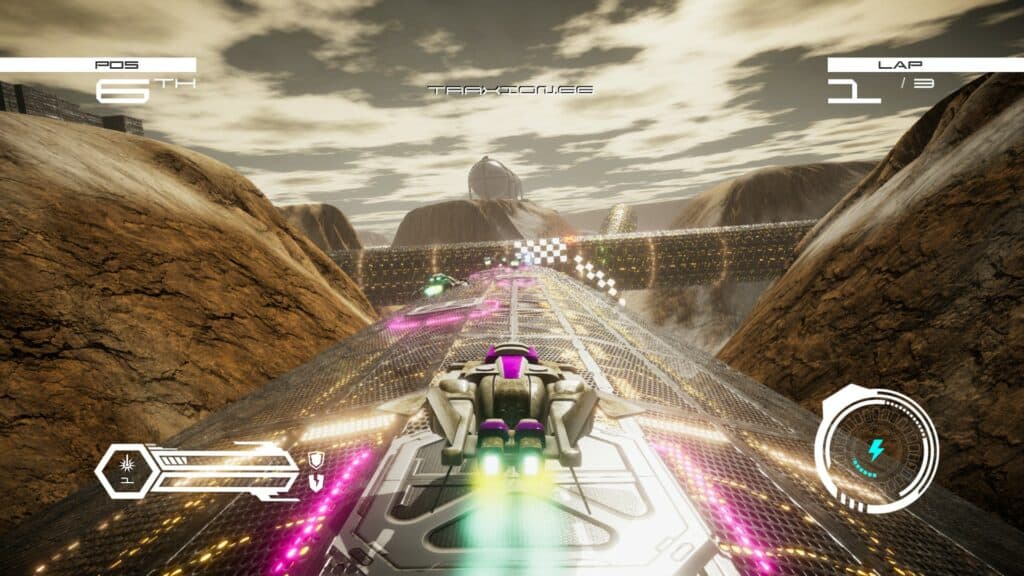
There are also additional power-ups to collect to top up your ship’s boost meter, and after lap one you can deploy it whenever you like – in much the same way as F-Zero. However, this will not affect your ship’s overall health, unlike Nintendo’s classic series.
I feel like sometimes the power-ups were difficult to hit – quite often I’d be charging towards a band of three boost icons and simply fly straight through the gap between the outer two. Maybe an off-course section where you could recharge your boost/shields would have been a better option – like a rallycross Joker lap but without any pesky anti-gravity Olsberg Fiestas to deal with.
Total wipeout
Combat Race mode adds further collectable power-ups to the mix – shield and ammo pickups. Ammo lets you shoot X-Wing style laser beams at your opponents thanks to a handy lock-on feature, while shield pickups help defend the integrity of your ship when the roles are reversed.
I must say I didn’t enjoy Combat Races as much as Arcade – it was extremely difficult to avoid being destroyed by the AI.
After persevering for a couple of hours, I finally worked out that pulling a gap on the field on the opening lap, when power-ups, boost and weapons are disabled, was the best method for victory.
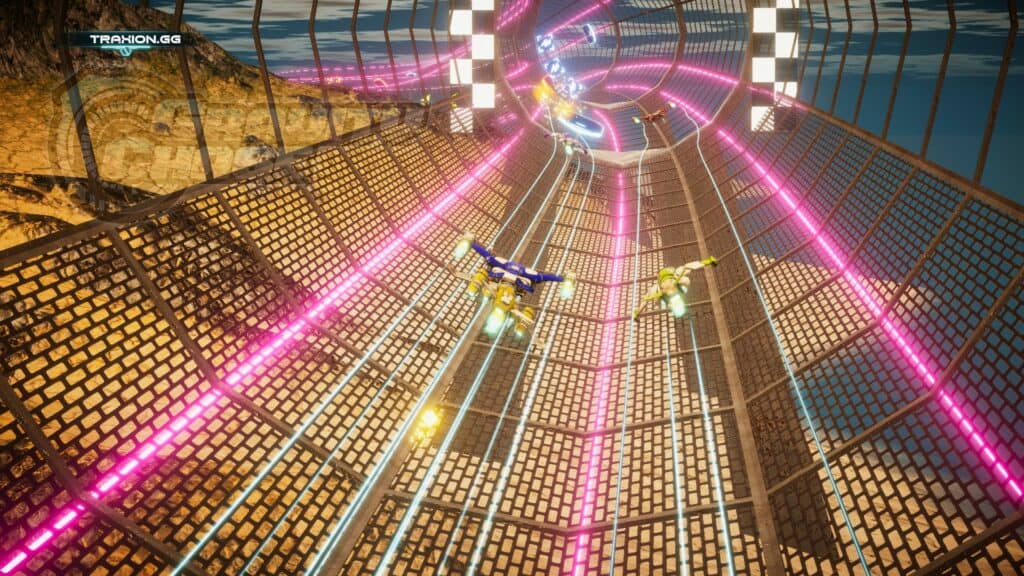
This meant learning the location of boost pads and nailing every single one. Otherwise, I was bogged down in combat that was difficult to defend against, despite activating a shield to minimise damage. In this instance, picking a slower, theoretically sturdier, ship doesn’t seem to help.
There are no other weapons except twin laser blasters, and no other form of attack other than ramming, but this hurts top speed too much to be worthwhile. I feel like more weapon variety and a reduction in the effectiveness of the AI’s sharpshooting skills would have made a more positive impact on this mode.
Death Race 2097
Elimination Race is the third and final event option in Gravity Chase. Essentially, it’s a last ship standing race, where the player in last position when the timer runs out is disqualified. This is my least favourite mode, as it feels like the cards are stacked against you from the outset.
I noticed that even though I hit more boost pads than my opponents and had a faster ship, I struggled to close the gap to them. With your ship’s boost and weapons disabled, and no power-ups to collect other than ship repair, it feels like every race is a lost cause – even on beginner difficulty.
It was in my first Combat and Elimination races that I noticed a huge leap in difficulty. It seems like when you pick a faster ship to race with – Speed Class 2 and 3 – the AI’s abilities grow exponentially, which feels a little random and unfair.
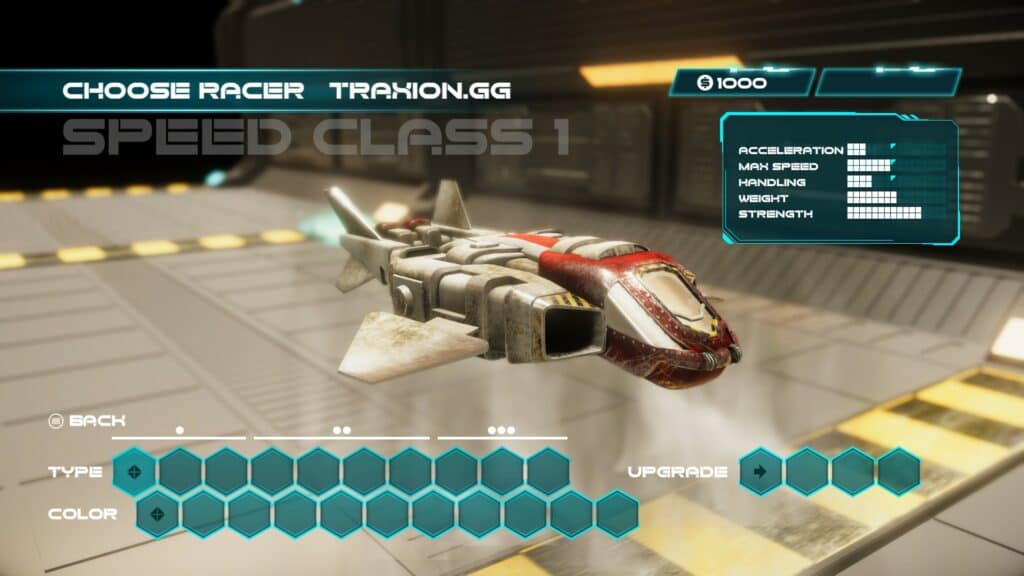
In fact, I blew away my personal best race times from Arcade mode but still finished third or fourth in combat races, even while using the same ship. Then in Elimination races, I was almost always first to be disqualified.
I switched back to Speed Class 1 and immediately won by a country mile.
Track variety isn’t great either – most are pipes or tunnels, with the occasional wipE′out″ style half-pipe thrown in. Mixing the action up across flat circuits, pipes and tunnels, with a few jumps through in for good measure, would help break up the monotony.
Tracks and ships also have no names, so it’s difficult to tell anyone which is your favourite. Customisation options are on the light side too, but these are minor quibbles in what feels like a well-sorted concept.
Zero-G Mr Magoo
Despite the few creases that need to be ironed out, there’s still a lot to like in Gravity Chase. As stated previously, the sounds are excellent – especially the music – and barring the slightly weedy laser beam, the incidental sounds are robust enough.
Plus, the neon-infused visuals look impressively fluid during gameplay, with barely a hint of slowdown even when speeds go supersonic.
Background details such as swaying palm trees and fire-spitting volcanoes add a bit of colour without distracting from the action on screen.
Having said that, the proliferation of neon gets a bit much sometimes, and it’s difficult to differentiate between boost pads, power-ups and the light trails left by your opponents, especially on the darker, redder, maps.
Quite often I didn’t even see an opponent until I’d crashed into them, like some sort of zero-G Mr Magoo.
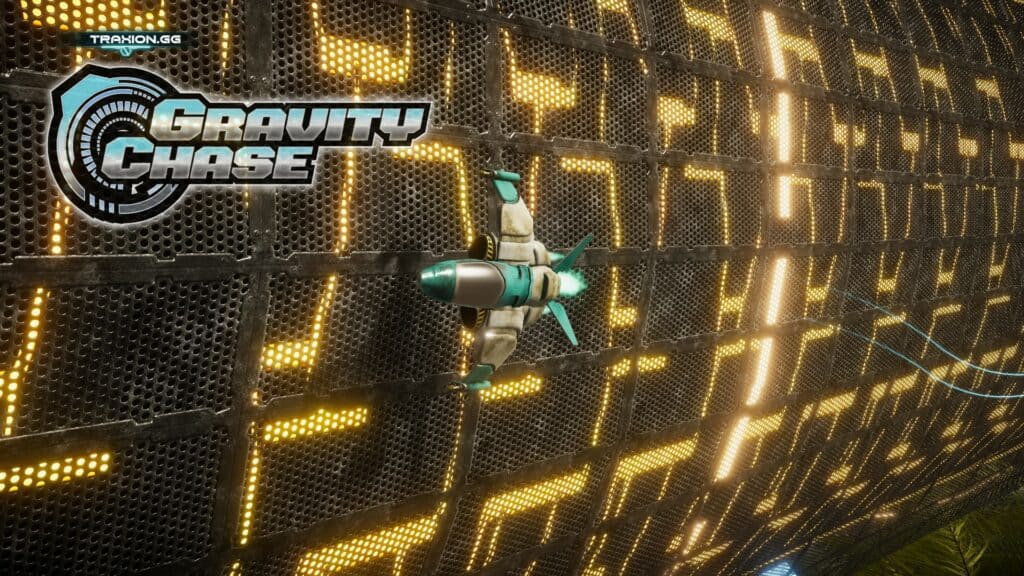
Arcade Races are excellent. For me, they evoke similar feelings I got spending that summer playing F-Zero X. Piloting a super-fast ship through a narrow tunnel at insane speeds while dodging opponents and scrabbling to find boost pads and other power-ups.
The ships handle intuitively and when you hook up consecutive boost combos the action flies along at breakneck speed, and this is where Gravity Chase feels at its best. The ability to play with three friends locally is a bonus and mitigates the lack of an online multiplayer feature a tad.
Following on from the success of Formula Retro Racing – a game we are a big fan of – Repixel8 has delivered another solid budget indie racing game. At £9.99/$11.99 on PC and Xbox One, it’s exceptional value, and well worth considering if you’re a fan of zero-gravity racing.

| Developer | Repixel8 |
| Release date | 21st January 2022 |
| Available platforms | PC (Steam) and Xbox One |
| Version tested | PC (Steam) |
| Best played with | Controller |
Full disclosure: A code for the game was provided by the publisher for review purposes. Here is our review policy.
*yeah, I’ve heard of The Weeknd – I’m up to speed with the youth of today and all their popular beat combos.






